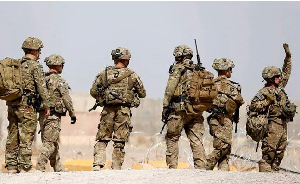- Home - News
- TWI News | TV
- Polls
- Year In Review
- News Archive
- Crime & Punishment
- Politics
- Regional
- Editorial
- Health
- Ghanaians Abroad
- Tabloid
- Africa
- Religion
- Election 2020
- Coronavirus
- News Videos | TV
- Photo Archives
- News Headlines
- Press Release
General News of Thursday, 1 March 2012
Source: The Business Analyst
Western Chiefs Endorse Gas Project
… Amidst Jomoro Youth Protest
By J. Ato kobbie, Managing Editor [The Business Analyst]
The 2012 first General Meeting of the Western Regional House of Chiefs came off last week, with a call on all chiefs and stakeholders in the region, to lend support to the Ghana Gas infrastructure project, for it to facilitate the development of the region.
The meeting, which saw all the Paramount Chiefs of the region, elders and other stakeholders, converge at the Regional House of Chiefs on Thursday, February 23, 2012, was briefed by a high-powered Ghana National Gas Company (Ghana Gas) team, led by its Chief Executive Officer (CEO), Dr. George Sipa-Adjah Yankey, who gave an overview of their activities and the status of the Gas infrastructure project as well as what has necessitated a change in site for the gas processing plant.
At the end of the three-hour long deliberations, the President of the House, Awulae Attibrukusu III, appealed to the Chiefs and Elders of the region, to help educate, especially the youth, to clear misconceptions that they may have about the gas project and also on all the people of the region to lend their support, no matter where it would be sited in the region.
“Initially, we thought they were going to move the whole project from Domunli to Atuabo; God being so good, we invited the Ghana Gas and they have been able to explain that it is only a unit of the project that is being taken from Domunli to Atuabo due to technical and financial considerations,” the president of the House was to tell newsmen.
According to him the project was going to improve the fortune of Nzemaland because the people of the Western region in general have been sidelined for a long time.
“So, if there is relocation and it is only one unit being set up within another area in the same region, then what is the problem,” he quizzed, adding, “So there isn’t anything more for Nananom to say than to give our blessing to the government to go ahead.”
Dissent
Apart from Awulae Annor Adjaye III, Paramount Chief of the Western Nzema Traditional Council, who expressed strong reservations about the change in the original plan to site the gas project within his area of jurisdiction, the chiefs found it refreshing that it was only the gas processing plant unit that was being relocated to Atuabo in the Ellembele District, whereas plans for a Volta River Authority (VRA) power plant as well as petrochemical industries at the Domunli enclave in the Jomoro District, remained unchanged, contrary to what they were earlier made to believe.
Also dissatisfied with the turn of events was the Member of Parliament for Jomoro, Ms. Samiah Nkrumah, who protested vehemently against relocating the processing plant from the Domunli enclave, which is within her Jomoro Constituency to Atuabo in the Ellembele Constituency.
Meanwhile, as the meeting went on youth from Jomoro, clad in red and black, with red arm bands waved placards, singing and chanting in protest against news of the relocation, and threatening to resist the move.
Project update
The Ghana Gas presentation, which was made by Mr. Victor Sunu-Attah, Director (Project Development) with support from Dr. Yankey and Dr. Ben Asante, Pipeline Consultant to Ghana Gas, gave the chiefs an overview of the company’s mandate and activities, before giving an update on the early phase gas infrastructure project.
The team impressed upon the House that even though final studies were being conducted on the Atuabo site for the location of the gas processing plant, that site appeared to be the best choice within the time frame available for implementing the project, for both economic and technical reasons.
The Ghana Gas CEO dispelled suggestions that the choice of Atuabo was for political expediency, explaining that even though several previous studies had also identified the site as the preferred choice for the gas processing plant, the current decision was based on the recommendation of the Sinopec, which is the company tasked to implement the gas infrastructure, after undertaking a detailed study.
The team revealed that demarcation, geophysical and hydraulogical survey is near completion at the Amansure River area near Atuabo, which is the site earmarked for locating the gas processing plant.
Again, Ghana Gas revealed that specifications for both the offshore and onshore pipelines are completed, while the shallow water pipeline front end engineering and design (FEED) and detailed design studies as well as land pipeline engineering were ongoing.
According to Ghana Gas, together with its contractor, SINOPEC, they are in the process of procuring various dimensions of pipeline to be laid to transport natural gas from the Jubilee Field to the gas processing plant and also wheel processed gas to the Aboadze Thermal Plant as well as a new VRA power plant to be installed at the Domunli enclave.
The pipelines being procured are 40-kilometre 12-inch pipeline, which would be laid from the termination point of the deepwater pipeline, previously laid by Technip from the Jubilee Field to shallow water, to the Gas Processing Plant.
Also being procured are 110km of 20-inch pipeline, which would be laid from the Gas Processing Plant, to wheel processed gas to Aboadze; 75km of 20-inch pipeline to be laid from Esiama to Prestea, as well as 20km of 10-inch pipeline which would be laid from the gas processing Plant to Domunli and Nauli.
Rudan Engineering Limited has also completed demarcation and surveying of the 18.9 km2 tract of land, including the buffer zones in the Domunli area, which is earmarked for power generation, fertilizer production, methanol, and petrochemical industries, such as plastics.
“This is an exciting time for the Western region,” Dr. Asante, who has over 23 years experience, working on pipelines told the Chiefs, enumerating the benefits that would come when the project is implemented.
Illustrating the course of the pipeline and advantages of the site options, Dr. Ben Asante said just in capacity of onshore pipelines alone, the Atuabo site would deliver to Aboadze 425mscf of processed gas whereas the Domunli site can deliver 385mscf, due to distance differences.
Dr. Asante said this, coupled with capital expenditure, material and construction costs makes the Atuabo site the preferred choice.
He said not meeting the time schedule for implementing the project would adversely affect the Jubilee Field, in terms of both oil and gas production levels as well as the reservoir itself.
He explained that substituting light crude oil which VRA currently uses to fuel the Aboadze Thermal Plant with processed gas alone would save one million dollars per day.
Giving the Chiefs insight into the technical justifications for the site selection, Mr. Sunu-Attah said the Atuabo site is low-lying plain grassland with virtually no trees, which “makes the clearing exercise during site preparation much easier and less costly, and effectively reducing the project schedule.”
Again, the low laying flat nature of the land at Atuabo requires minimal leveling, even though some filling will be required to raise the site area above the seasonal flood levels. On the other hand, “the irregular and undulating topographical nature of the Domunli site means that significant cutting and filling will be required with significant adverse impact to project schedule and cost.”
Furthermore, the existing access road at Atuabo presents the project with a significant time saving advantage compared to the construction of new access roads in Domunli site, which has densely grown cash crops and forest.
The existence of an 11kv power lines running over the Atuabo site presents a ready, clean and safe source of power to be used during construction, commissioning and operation of the plant, which is not the case with the Domunli site.
Land and Resettlement Issues
Ghana Gas submitted further that whereas Atuabo has fewer communities (i.e. three) to be impacted compared to Domunli, which has nine, land acquisition, schedule and costs are expected to be minimal.
“What we are saying is that hitherto, we had time,” Mr. Sunu-Attah emphasized stressing that there were social issues such as resettling people who had lived all their lives on their ancestral lands which were being dealt with.
“But for now, we have fire on our backs,” he appealed.
He said whereas the Domunli area will require the relocation and resettlement of the Bokakole village and its residents, there are no resettlement issues at Atuabo.
Compared to the Domunli site, there will be minimal property enumeration requirements at the Atuabo site, where it is anticipated that compensation requirements, if any, will be very minimal.
The Ghana Gas team conceded that even though there were strong indications that a court action, initiated by some locals in the Domunli area would be withdrawn, that action posed a significant threat to the successful completion of the Ghana Gas Infrastructure Project.
Parliament has already approved a subsidiary agreement covering $850million of a $3billion China Development Bank (CDB) loan for the gas infrastructure project.
The Western Regional Minister, in a brief remark to the House, appealed to the chiefs and people of the region to desist from playing politics with this all-important project for the region to become the ultimate beneficiary. Also present at the event was the Sekondi Municipal Chief Executive as well as some opinion leaders. j.atokobbie@yahoo.com
A print version of this article is published in The Business Analyst, Wednesday, February 29th – Tuesday, March 6th, 2012.










